December 4th, 2020
Using visuals with English Language Learners is one of the easiest strategies to employ, yet it’s also one of the ones that we teachers can forget to use once the day gets rolling and the needs of many students come into play, especially if we are not particularly gifted or confident with visual art skills (as an auditory learner, I’ve always struggled to “make things visual”, and my primary students, students with communication needs, and English Language Learners taught me how to overcome the fear of putting my sloppy stick-figure art out there as a tool to make content more comprehensible for my students).
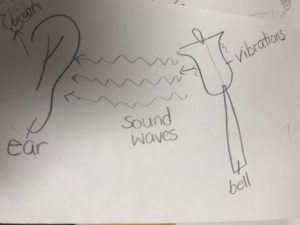
Hand-drawn visual prompt for grade four ESL and ELD students to help explain how sound waves travel.
We know that even the earliest STEP 1 ELLs can make meaning from photographs and drawings, even if they have had no prior schooling and do not yet have strong first language literacy skills. If technology is available, a simple Google image search can mean the difference between understanding and engagement, or confusion and disengagement. If technology is not available, even hastily drawn stick figures can do much to convey important/key vocabulary or concepts. Students at early STEPs can often represent their thinking visually using slideshows, visual creation apps such as PicCollage, or simple drawings. When we have technology at our disposal, kids can also create their own visuals using the camera on a device to take photos of real objects encountered on a field trip or in their environment. Visuals can level the playing field in so many ways, and they need not require great skill or time to employ.
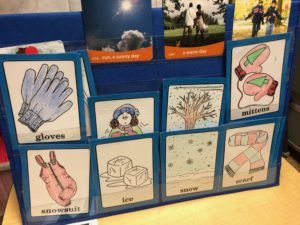
Visual vocabulary prompts for STEP 1 newcomers who arrived during the winter season, to help them speak and write about their experience of their first Canadian winter
Many primary teachers ask students to create their own alphabet books with pictures of familiar objects or people to represent each letter. I’ve seen this expanded into a frieze that is posted on a classroom wall for primary students to use in their writing. Newcomer students can go around the school with a buddy to take photographs of the various rooms and staff in a school, as an introductory activity, to make into a little booklet, slideshow or a Google doc that they can share with their families. Visual word walls for mathematics, Science, or Social Studies/History/Geography can go a long way toward ensuring that important content area vocabulary is understood and is easily accessible by ALL students. I’ve also had students from the same cultural group create visual charts for each other, to help scaffold each others’ work in culturally relevant ways. I may not, for instance, have thought of including a picture of tabouleh on a chart about healthy eating and food groups, but my students sure did.
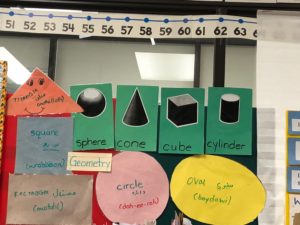
Partially completed dual-language math word wall for geometry for STEP 1 and 2 ESL and ELD students.
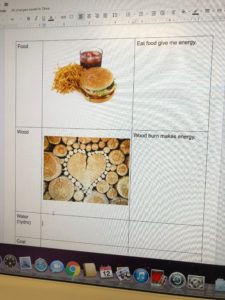
Visuals in a chart used to scaffold STEP 1 and 2 junior ELD student writing about different types of energy in Google Docs.
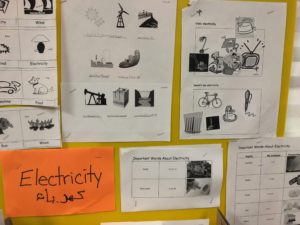
Dual-language visual word wall for Grade 6 Science Electricity unit, co-created by ELD and ESL students from different schools using our ESL Google Classroom and visuals from the internet.
Many native English speakers can benefit from the use of visuals to help them anchor important vocabulary and concepts as well. This is definitely a strategy that is essential for some and beneficial for all. When students are actively involved in the creation of interactive visual word walls and anchor charts, they are more likely to actually use them to support their learning. Students can draw pictures, take photographs, or do internet image searches to help find visuals to help them remember important content area vocabulary and concepts.
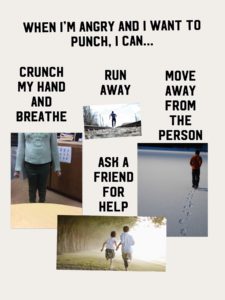
Student-created visual self-regulation problem solving chart by a STEP 3 student with a refugee background, done with the PicCollage app.
I’ve had tremendous success with anxious newcomer students using communication boards comprised of simple picture cards (hand-drawn, hastily sourced from the internet, or PECS from a program such as Boardmaker). Simply being able to point to a picture to communicate a basic need such as “bathroom”, “drink”, or “eat” can greatly reduce the pressure that students feel when they first arrive and can be overwhelmed by their surroundings. Some students also benefit from visual reminders of items they need to be prepared for the day, the order of items needed to get dressed and ready for home, the items needed to complete a task (one teacher I knew had velcro dots up on her chart stand and would velcro one of each type of tool needed to complete the task at hand, such as a glue stick, scissors, markers, etc.). It was a highly visual technique that was effective for all of the learners in the class, and cut down on the time it took for her students to get themselves organized and on task, freeing the teacher up to check in with the students who needed assistance to get started.
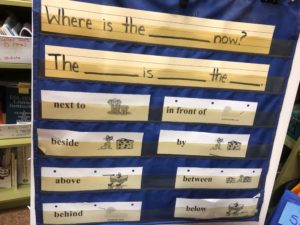
Visual chart with sentence frames to support STEP 1 and 2 students to use prepositions of place in their oral language and written work.
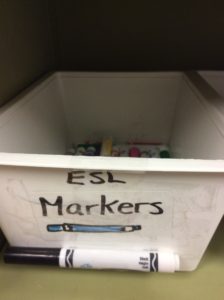
Bin labels with simple drawings or physical objects stuck onto them can help ALL students to quickly and confidently know where to access learning materials.
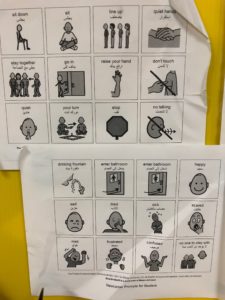
Dual language newcomer picture cards for expressing basic needs and feelings were developed by WRDSB staff for use with newcomer refugee students from Syria using the Boardmaker program.
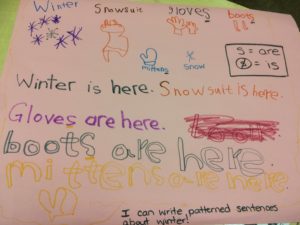
STEP 1 ELD students created these simple drawings as vocabulary prompts to help them with their patterned sentence writing in a response to a guided reading text about winter clothing.
Using visuals in the regular or resource classroom does not have to be labour-intensive, nor does it have to involve a great deal of artistic skill or time. In many cases, the students themselves can be the creators of the visuals they need, or can at least locate them using a Google image search. Using visuals to support comprehension makes content more accessible and comprehensible for ALL students, and can help teachers to cut down on wasted time in the classroom.
Tags: Comprehensible input · ELD · ELL · ESL · Visuals
